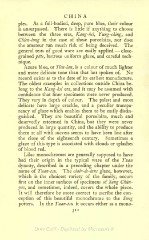Page 386 - Oriental Series Japan and China, Brinkly
P. 386
CHINA
pies. As a full-bodied, deep, pure blue, their colour
is unsurpassed. There is little if anything to choose
between the three eras, Kang-hsit Yung-ching, and
Chien-lung in the case of these porcelains, nor does
the amateur run much risk of being deceived. The
general tests of good ware are easily applied close-
grained pate, lustrous uniform glaze, and careful tech-
nique.
Azure blue, or Tien-Ian, is a colour of much lighter
Noand more delicate tone than that last spoken of.
record exists as to the date of its earliest manufacture.
The oldest examples in collections outside China be-
long to the Kang-hsi era, and it may be assumed with
confidence that finer specimens were never produced.
They vary in depth of colour. The palest and most
delicate have large crackle, and a peculiar transpa-
rency of glaze which enables them to be easily distin-
guished. They are beautiful porcelains, much and
deservedly esteemed in China, but they were never
produced in large quantity, and the ability to produce
them at all with success seems to have been lost after
the close of the eighteenth century. Sometimes a
glaze of this type is associated with clouds or splashes
of blood red.
Lilac monochromes are generally supposed to have
had their origin in the typical ware of the Yuan
dynasty, described in a preceding chapter under the
name of Yuan-tsu. The clair-de-lune glaze, however,
which is the choicest variety of the family, occurs
first on the inner surfaces of specimens of Sung Chun-
yao, and sometimes, indeed, covers the whole piece.
It will therefore be more correct to ascribe the con-
ception of this beautiful monochrome to the Sung
potters. In the Yuan-tsu it occurs either as a mono-
312

